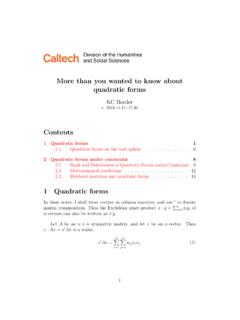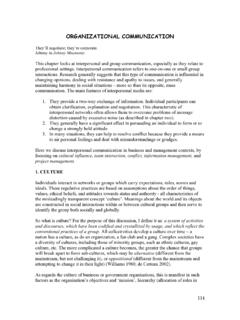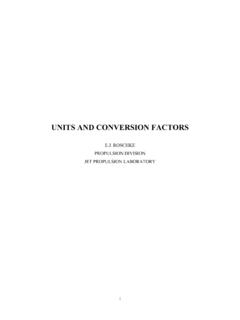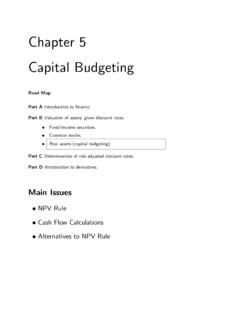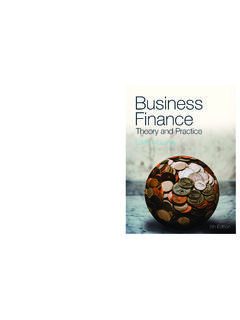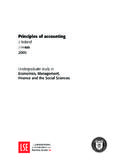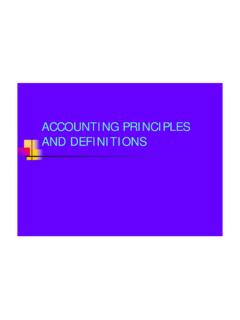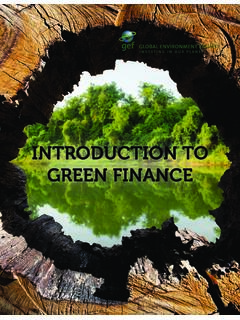Transcription of Chapter 1 Introduction to Finance
1 Chapter 1. Introduction to Finance Road Map Part A Introduction to nance. Financial decisions and nancial markets. Present value. Part B Valuation of assets, given discount rates. Part C Determination of risk-adjusted discount rates. Part D Introduction to derivatives. Main Issues What Is Finance Valuation of Assets Opportunity Cost of Capital Present Value (PV). Role of Financial Markets Objectives of Financial Manager Chapter 1 Introduction to Finance 1-1. 1 What is Finance ? Finance is about the bottom line of business activities. Every business is a process of acquiring and disposing assets: Real assets (tangible and intangible).
2 Financial assets. Two objectives of business: Grow wealth. Use wealth (assets) to best meet economic needs. Financially, a business decision reduces to valuation of assets. Valuation is the central issue of nance. Fall 2006 . c J. Wang Lecture Notes 1-2 Introduction to Finance Chapter 1. Questions we would like to answer in this course: 1. How nancial markets determine asset prices? 2. How corporations make nancial decisions? Investments: - What projects to invest in? Financing: - How to nance a project? Payout: - What to pay back to shareholders? Risk management: - What risk to take or to avoid and how? Lecture Notes . c J.
3 Wang Fall 2006. Chapter 1 Introduction to Finance 1-3. Cash Flow of A Firm (2) (1).. Firm's Financial Investors (4) individuals Operations Manager institutions .. - - (3) (5). (1) Cash raised from investors by selling financial assets. (2) Cash invested in real assets (tangible and intangible). (3) Cash generated by operations. (4) Cash reinvested. (5) Cash returned to investors. mandatory ( loan payments). discretionary ( dividends). Fall 2006 . c J. Wang Lecture Notes 1-4 Introduction to Finance Chapter 1. Task of Financial Manager (2) (1).. Firm's Financial Investors (4) individuals Operations Manager institutions .. - - (3) (5).
4 Action: Manage cash ow (1), (2), (4), (5). Investment: (2) (3). Financing and payout: (1), (4), (5). Risk management: (1) and (5). Objective: Create value for shareholders. Lecture Notes . c J. Wang Fall 2006. Chapter 1 Introduction to Finance 1-5. To make sound nancial decisions, we need to know how to value assets. Investment decision: How real assets are valued. Financing and payout: How corporate securities are valued. Risk management: How nancial contracts are valued. Fall 2006 . c J. Wang Lecture Notes 1-6 Introduction to Finance Chapter 1. 2 Valuation of Assets Each asset is de ned by its cash ow (CF). Time: 0 1 2 . Cash out: CF 0.
5 Cash in: CF 1 CF 2 . Net cash ow: ( )CF 0 CF 1 CF 2 . Value of an asset = Value of its cash ow: Important Characteristics of A Cash Flow 1. Time: time value of money. Example. $1,000 today vs. $1,000 next year. 2. Risk: risk premium. Example. $1,000 for sure vs. $0 and $2,000 with equal odds. Time and uncertainty are two key elements in nance. Lecture Notes . c J. Wang Fall 2006. Chapter 1 Introduction to Finance 1-7. Approaches to Asset Valuation 1. Valuation by matching : (a) The nancial market contains a rich set of traded assets. (b) Given a CF, nd a traded asset with equivalent CF: Timing. Risk. (c) Value of CF equals the market price of the traded asset.
6 Assets with same payo s have same prices. 2. Valuation by analysis of demand/supply (equilibrium). Fall 2006 . c J. Wang Lecture Notes 1-8 Introduction to Finance Chapter 1. Opportunity Cost of Capital An investment is an acquisition of an asset: Pay cash today. Receive cash ow in the future. Capital investment trade-o : 1. A rm can always give cash back to shareholders. 2. A shareholder can invest in nancial markets. ' $. Investment opportunities Project . CASH - Share- - holder available in nancial & % markets Invest Dividend Invest De nition: Opportunity cost of capital is the expected rate of return o ered by equivalent investments in nancial markets.
7 Lecture Notes . c J. Wang Fall 2006. Chapter 1 Introduction to Finance 1-9. Present Value Example 1. How much is a sure cash ow of $1,100 in one year worth now? Safe assets in nancial markets o er 5% annual return. A potential buyer of the sure CF also expects 5% return. Let the price be X . Then X(1 + ) = 1, 100. Thus, 1, 100. X= = $1, 048. which is the CF's present value, , its current market value. Observation: Present value must properly adjust for time. Fall 2006 . c J. Wang Lecture Notes 1-10 Introduction to Finance Chapter 1. Example 2. How much is a risky cash ow in one year with a forecasted value of $1,100 worth now?
8 Assets of similar risk in nancial markets o er 20% return. A potential buyer of the risky CF also expects 20% return. Let the price be X . Then X(1 + ) = 1, 100. Thus, the present value of the risky CF is 1, 100. X= = $917. Observation: Present value must properly adjust for risk. The di erence in (expected) return between risky and safe assets is the risk premium. The present value of an CF equals its expected value discounted at the opportunity cost of captial. Lecture Notes . c J. Wang Fall 2006. Chapter 1 Introduction to Finance 1-11. 3 Role of Financial Markets Financial Markets at Center of Universe Individuals & %. ' $.
9 Financial Markets &. Financial Intermediaries & %. ' $. Firms Fall 2006 . c J. Wang Lecture Notes 1-12 Introduction to Finance Chapter 1. Financial Markets - where nancial assets are traded - Money markets: Short-term debt securities Short-term government debt (T-bills, ..). Short-term bank and corporate debt (CDs, CPs, ..). - Capital markets: Long-term securities Government debt (T-notes and T-bonds). Corporate debt Stocks, .. - Derivatives: Securities with payo s tied to other prices Forwards and futures Options, .. Financial Intermediaries - Own mostly nancial assets - Banks - Insurance companies - S&Ls - Mutual funds.
10 Corporations - Own mostly real assets Individuals - Own both real and nancial assets. Lecture Notes . c J. Wang Fall 2006. Chapter 1 Introduction to Finance 1-13. Functions of Financial Markets 1. Allocating resources: Across time. Example Borrow money to buy a home. Across di erent states of economy. Example Invest in stocks/bonds. 2. Communicating information. Market prices re ect available information. Assumptions on nancial markets A perfect nancial market: - A rich set of securities traded. - Free access. - Competitive trading process. - No frictions. Fall 2006 . c J. Wang Lecture Notes 1-14 Introduction to Finance Chapter 1.
